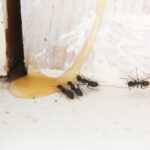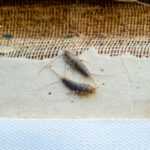Best Ways to Eliminate Fleas in House
Worried about Fleas in the House? This article will help you identify signs of fleas, effectively eliminate them, and prevent future infestations. Read on to learn practical methods for keeping your home flea-free and comfortable.
- Understanding the flea life cycle is essential for effective control, as killing only adult fleas is insufficient; all life stages must be eliminated.
- Early detection of fleas using signs like bites, flea dirt, and the White Sock Test can help prevent infestations from worsening.
- Regular cleaning, flea treatments for pets, and yard maintenance are key methods to effectively eliminate and prevent flea infestations.
Fleas and Their Life Cycle
Understanding the flea life cycle is key to effectively combating them. Fleas undergo four key stages: egg, larvae, pupae, and adult fleas. Adult fleas feed on the blood of their host, which can be your pet or even you, and lay eggs shortly after feeding. These eggs, which are tiny white objects resembling grains of sand, typically hatch within one to ten days under suitable conditions, leading to larvae that consume organic matter. Additionally, a common issue pet owners face is the presence of cat flea infestations.
Flea larvae spin a protective cocoon and enter the pupal stage, but adult fleas remain dormant until they detect a host nearby by sensing movement or warmth. Environmental factors such as temperature and humidity significantly affect the duration of a flea’s life cycle, which can last from several days to years. This is why a flea infestation can seem to appear out of nowhere and rapidly worsen.
Gaining knowledge about the flea life cycle aids in effective control. Killing adult fleas alone won’t suffice; eggs, larvae, and pupae must also be eliminated. This comprehensive approach is necessary to get rid of fleas and prevent future infestations.
Detecting Fleas in Your Home
Early detection keeps a small flea problem from turning into a big one. Watch for:
- Bites on people or pets
- Visible fleas on pets, bedding, or carpets
- Flea dirt (tiny dark specks that turn reddish-brown when moistened—digested blood)
- Tiny white grains that look like sand or salt (possible flea eggs)
Simple checks can help you confirm activity. Try the white sock test (walk across carpet in white socks and look for fleas that jump on) and test suspected flea dirt vs. regular dirt by moistening specks on a paper towel—flea dirt will bleed reddish-brown.
White Sock Test
The White Sock Test is a simple yet effective method to detect fleas. Wearing white socks and walking around suspected areas can help you easily spot fleas attracted by warmth. This test works well because the white background makes the fleas highly visible.
Walk around pet-frequented areas and observe if fleas jump onto your socks. If you spot any, it’s time to take action.
Flea Dirt vs. Regular Dirt
Flea dirt can easily be mistaken for regular dirt, but there’s a simple test to distinguish the two. Flea dirt turns reddish-brown when wet, indicating it is made from digested blood. Use a damp paper towel to test suspicious dirt; if it turns reddish-brown, it’s flea dirt. This is a clear sign that you are dealing with fleas.
Spotting bites on your skin, even if you don’t have pets, can also indicate exposure to fleas. Fleas can hitch a ride on your shoes or clothing, making it important to inspect your living areas thoroughly. If you identify flea dirt, it’s a strong indication of a flea infestation that needs immediate attention.
Effective Methods to Get Rid of Fleas
Quick action is necessary to prevent a flea infestation from worsening. Prompt control measures are necessary for managing heavy infestations. Daily vacuuming helps remove flea eggs, larvae, and adults from carpets and furniture. Using steam cleaning on carpets can effectively eliminate fleas at all life stages. Wash pet bedding in hot, soapy water to prevent flea infestations.
Using a flea comb can physically remove fleas and their droppings from pets. If home remedies do not effectively address a flea problem, it may be time to reach out to a professional exterminator. Certain flea species reproduce rapidly, making some infestations difficult to manage without professional help.
Treating Your Pet
Topical solutions, oral medications, and flea collars are recommended by veterinarians for effective flea control and the use of a flea control product. Topical treatments include a variety of products such as Actyvil, Bravecto, and Comfortis, while flea collars like Seresto offer long-duration protection. Administer flea treatments early in the year before populations build; topical treatments usually need monthly reapplication or longer, depending on the product.
If your pet is already receiving flea treatment, consult your vet about possibly switching to another product to ensure effectiveness. Verify that the flea treatment is safe for your specific pet, as not all treatments suit all animals.
Regularly grooming your pet with a flea comb can help remove cat fleas and their eggs.
Cleaning Pet Bedding
Hot, soapy water washes kill fleas and their eggs on pet bedding. It is recommended to launder pet bedding at least once a week to effectively control fleas.
To kill fleas effectively, pet bedding should be dried on high heat after washing.
Vacuuming Carpeted Areas
Immediately dispose of the vacuum bag or canister contents to prevent fleas from escaping back into the home. Thorough vacuuming removes adult fleas, larvae, and eggs from carpets, aiding in control. Pay special attention to carpet fibers where you can kill adult fleas and flea larvae might hide during vacuuming.
Regular vacuuming, combined with other flea control methods, effectively reduces flea populations in the house. Vacuum high-traffic areas daily or every other day, especially where pets frequent, to keep fleas at bay.
Treating Upholstered Furniture
Use targeted sprays specifically designed for upholstery to control fleas on furniture. Vacuum upholstered furniture thoroughly to remove fleas and flea debris.
Steam cleaning can effectively kill fleas and their eggs in fabrics.
Yard Maintenance
A clean yard helps eliminate flea habitats. Regular lawn mowing and debris removal reduce flea habitats in your yard. Beneficial nematodes and outdoor insecticides can be applied to the yard to control fleas.
Combining yard maintenance with insecticide or nematode treatments enhances flea control and the use of an insect growth regulator. Keeping your yard clean and free of debris can prevent fleas from entering your home and infesting your pets.
When to Call Professionals
If your flea infestation persists despite your efforts, it may be time to call pest control professionals. Seek professional pest control when home cleaning methods fail to resolve the infestation.
Professional pest control services can eliminate fleas from a home, addressing any remaining eggs. The cost of hiring a professional exterminator for fleas typically ranges from $75 to $400, depending on the severity of the infestation.
Preventing Future Infestations
Clean pet resting areas and vacuum carpets regularly to reduce flea populations. Sprinkling salt or baking soda on carpets or furniture absorbs moisture and kills flea eggs. Vacuum high-traffic areas daily or every other day, especially where pets eat or sleep.
Keeping all pets updated on flea medications is a crucial preventive measure against fleas. Flea shampoos are effective in killing adult fleas. However, they do not impact the eggs or larvae of fleas. Using essential oils after baths can help keep fleas away if suitable for the pets.
To prevent fleas, maintain a neat yard: mow regularly, remove debris, and reduce shaded areas. Certain plants, like fennel, lavender, and mint, can help repel fleas in your yard. Recognize that fleas can be a year-round problem due to milder winters.
Fleas are persistent pests that require a multi-faceted approach to control and eliminate. Understanding their life cycle, detecting their presence early, and employing effective methods to get rid of them are critical steps. Treating your pets, cleaning pet bedding, vacuuming carpeted areas, treating upholstered furniture, and maintaining your yard are all essential to preventing flea infestations.
Remember, if your efforts do not yield the desired results, do not hesitate to call professional pest control services. By taking these steps, you can ensure a flea-free home and a comfortable environment for both you and your pets.
Frequently Asked Questions
How to get rid of fleas?
To effectively get rid of fleas, vacuum your home daily to remove eggs, larvae, and adult fleas, while also washing fabrics and bedding in hot water. Additionally, consider using insecticides or consulting your veterinarian about flea control products for pets.
Is it safe to stay in a house with fleas?
Staying in a house with fleas is not safe, as they can transmit diseases such as plague, typhus, and cat-scratch fever. It’s crucial to address the infestation promptly to safeguard your health and well-being.
Why do I suddenly have fleas in my house?
You may have suddenly acquired fleas due to bringing in infested used furniture or clothing, or from flea eggs left by pets that have visited your home. It’s crucial to address the issue quickly to prevent further infestation.
How can I tell if my pet has fleas?
You can tell if your pet has fleas by observing excessive scratching, finding visible fleas, or noticing flea dirt in their fur. These signs indicate a possible flea infestation that needs to be addressed.
What should I do if home remedies don’t work for my flea infestation?
If home remedies don’t work, it’s essential to contact a professional pest control service for effective treatment and resolution of the flea infestation. They have the expertise and tools necessary to tackle the problem efficiently.





